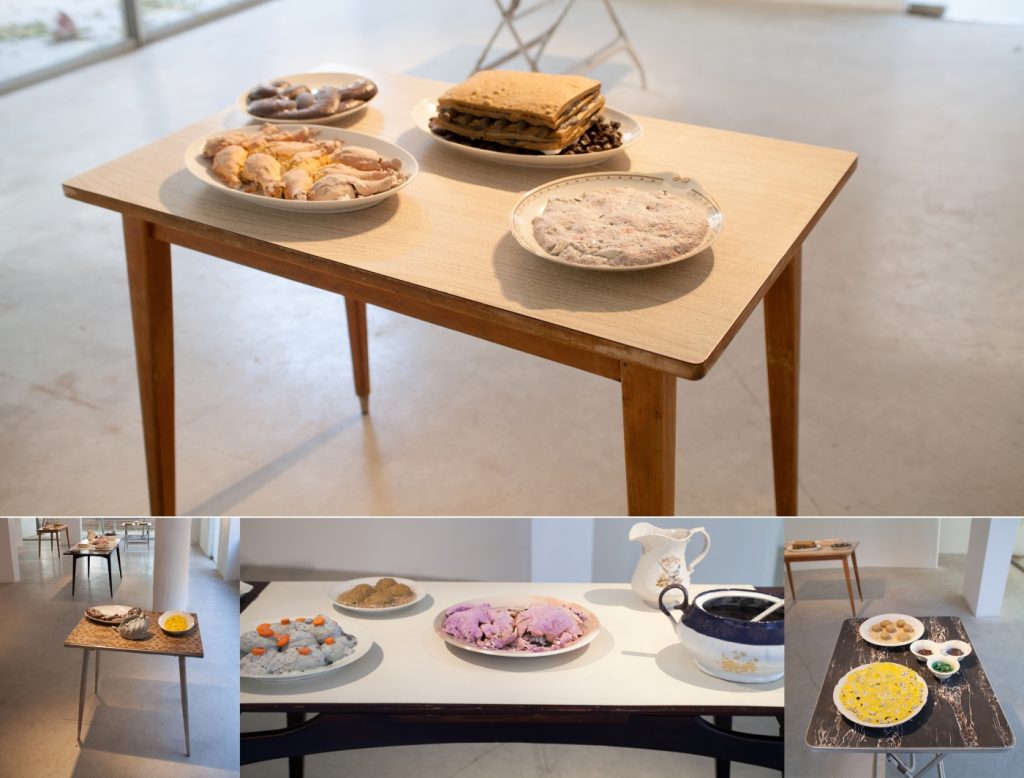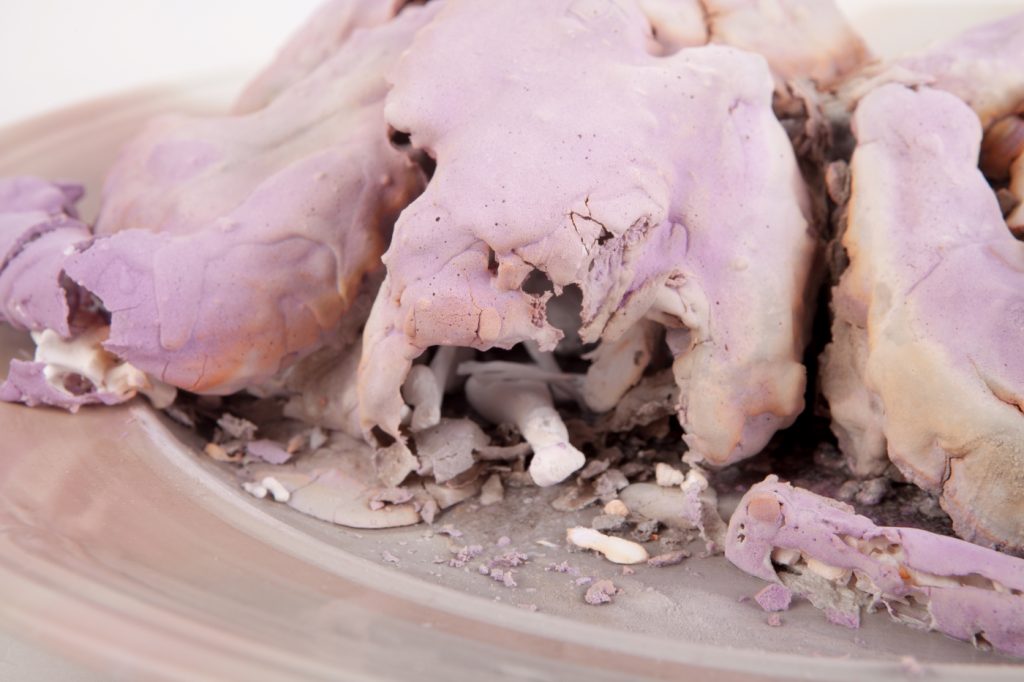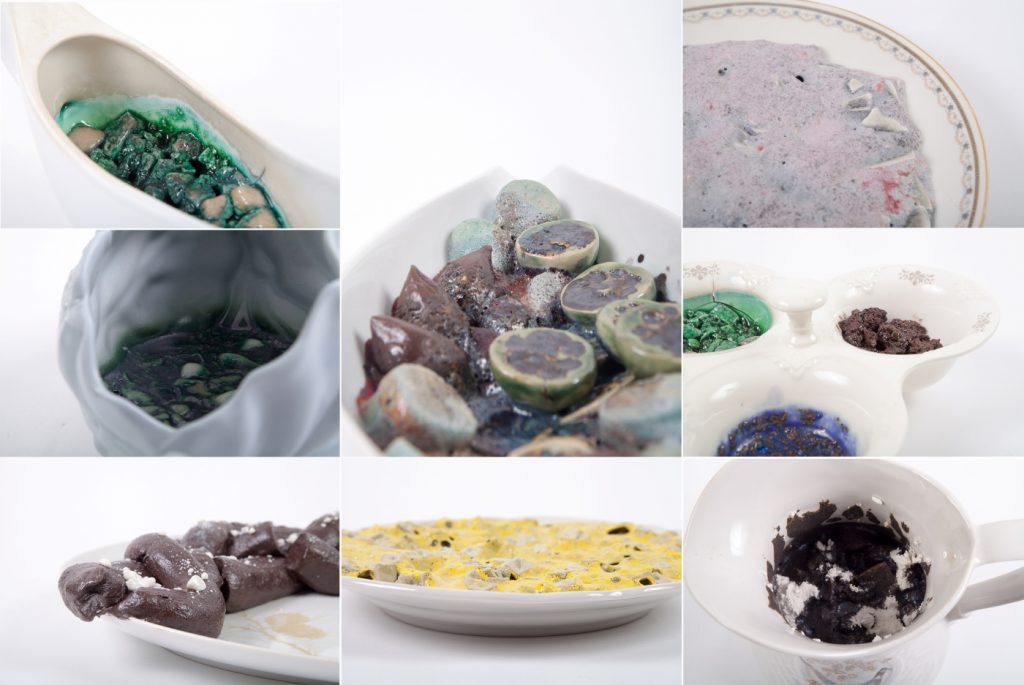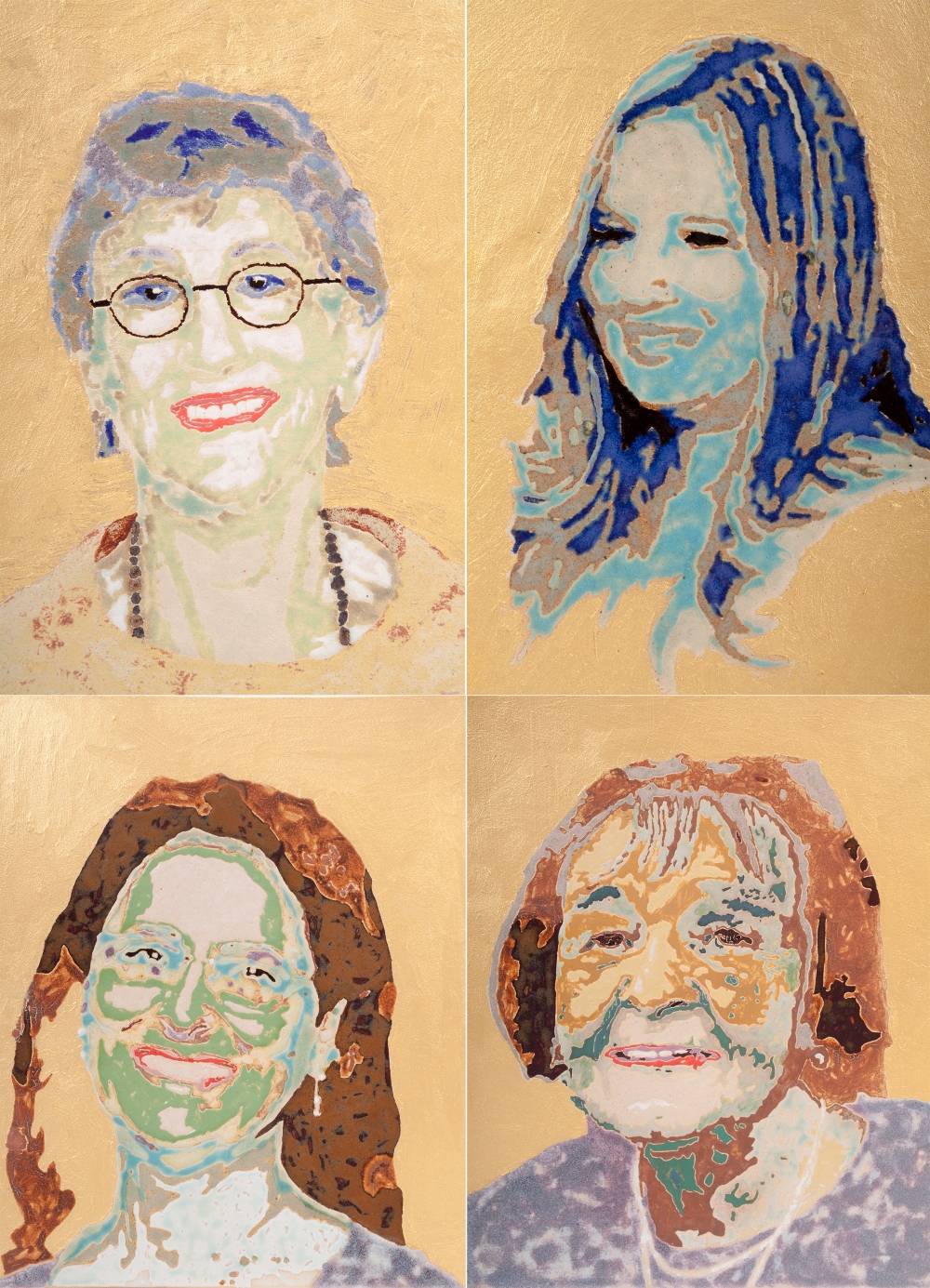Article by Erez Maayan
Five Formica tables, the kind found in almost every (Israeli) kitchen through the mid-1980s, on top of which are what appear to be fossilized meals. Twenty-one porcelain dishes filled with gastromorphic (food-resembling) matter that is completely and undeniably inedible while not completely identifiable. Platters crammed with what could resemble rotten patties with congealed gravy, putrid porridge or moldy gefilte fish; soup-tureen with a stiff, cloudy, jelly-like substance; gravy boats, appetizer platters and a tri-dip-bowl containing an unidentifiable, revolting mush. All are generously served in what could have been a festive meal that froze over. Hanging over the tables are four painted clay plates with images of four women in gold and glaze.
This is a description of Roy Maayan’s installation No Added Preservatives, presented in 2013 (curation: Erez Maayan). The artist returns to his biographical memory of dining, reminiscing about his childhood and gathering last fragments of remembrance just before they fade away.
Recent decades have witnessed an increased artistic interest in representing that which cannot be represented—memory. By nature, the representation of a memory – particularly private, familial memory – relies on the recollection of the person holding that memory. By definition, it is not objective. On the other hand, a personal memory is oftentimes mixed with collective memory, flirting with it and criticizing it from a position that is not committed to a common meta-narrative, thereby liberating it and enabling others to relate to it. No Added Preservatives grants this perspective to the Israeli suburban family of Maayan’s childhood and adolescence. The perspective does not conform to the common tendency to glorify the past, but rather problematizes it, as well as the relationship between past, memory, and representation.
French historian Pierre Nora makes a distinction between environments of memory (milieux de mémoire) and sites of memory (lieux de mémoire), which requires a further distinction between history (the historiographical act) and memory (the act of remembering)[1]. Memory is life, “open to the dialectic of remembering and forgetting, unconscious of its successive deformations, vulnerable to manipulation and appropriation, susceptible to being long dormant and periodically revived”. By contrast, history “is the reconstruction, always problematic and incomplete, of what is no longer”[2]. Memory is an experience in an eternal present while history is a representation of the past. History is an intellectual, prosaic act that belongs to everyone and no one due to its claim to universal authority. History calls for critical discourse while memory instills remembrance within the sacred and “is by nature multiple and yet specific; collective, plural, and yet individual”[3]. As such, spontaneous memory takes root in the concrete, in everything experienced – space, gesture, image, and sense – and thus consigns the past to the future. In contrast, the historiographic act is a selective, linear process that reorganizes relations between temporal continuities, therefore making it an act of annihilation – rather than glorification – of what has taken place. These dialectics between memory and history result in history’s perpetual suspicion of memory and its aim to suppress and destroy it, as exemplified by archives, museums, medallions, and monuments that drain the past of its ability to relate to an individual’s own experienced memory. It seems that our relationship with the past is “no longer a retrospective continuity but the illumination of discontinuity”[4].
Nora argues that modern memory is no longer spontaneous, psychological, individual, and subjective, but rather or, above all, archival, relying entirely on the materiality of the trace, the immediacy of the recording, the visibility of the image[5]. “The passage from memory to history has required every social group to redefine its identity through the revitalization of its own history. The task of remembering makes everyone his own historian”[6]. This results in a growing obsession with the archive, the urge to completely conserve the present, as well as totally preserve the past, as manifested in the increasing number of museums, libraries, depositories, centers of documentation, data banks, anniversaries, eulogies, notarized bills, etc. Since modern man no longer possesses spontaneous memory, these new archives are no longer a reminder of the living memory; they have become the conduit to lost memory, a prosthetic memory. They became sites of memory (lieux de mémoire) due to a lack of environments of memory (milieux de mémoire)[7]. These lieux de mémoire fundamentally remain the ultimate embodiments of a memorial consciousness that has barely survived in a historical age that calls out for memory because it has abandoned it.[8]
Lieux de mémoire are a strange hybrid, subject to both memory and history: at once immediately available in concrete, sensual experience and susceptible to the most abstract elaboration. Their primary goal is “to stop time, to block the work of forgetting, to establish a state of things, to immortalize death, to materialize the immaterial”[9]. What sets them apart from every previous historical or scientific approach to memory, which is concerned mainly with realia is that lieux de mémoire have no referent in reality; or, rather, “they are their own referent: pure, exclusively self-referential signs”.[10]
I would like to demonstrate that No Added Preservatives is a unique form of lieu de mémoire. Nora states “the less memory is experienced collectively, the more it will require individuals to undertake to become themselves memory-individuals”[11]. In his work, Roy Maayan exemplifies this memory-individual, attempting to constitute his identity by constructing his own archive for the non-archival, the temporal, a fragment of memory. The installation is a lieu de mémoire in which memory residues are accumulated, selectively cataloged and given eternal life in nonperishable material, while simultaneously stressing its decay as memory. Creating the pieces for the dining installation is, much like a historiographical act, a deliberate process of formalizing, an illusion of memory reconstruction. The use of clay that is incapable of capturing an event as it happens, rather than a more reproductive media (such as video or audio recording), emphasizes the artist’s inability to recall any memories in this modern era, not even through obsessive archiving. Some of the objects even contain what appears to be actual food residues, preserved in matter, but altered, disintegrated and decayed.
In this sense, No Added Preservatives could be considered a lament for the lost art of memory vis-a-vis history. It is quite clear that the images are inspired by Flemish food paintings of the 17th century, an age that preceded the tyranny of history, in which memories were conceived and captured not by immediate archiving but through a durational process. A process in which there was no need for complete realia in representation when images were illuminated and displayed in an exaggerated and elevated manner. As the artist’s memory derives not from the 17th century Renaissance dining, but his own, instead of exotic aphrodisiacs he presents the classic ‘Israeli’ dining table—a common yet personal biographical memory of a specific time and period, though this table has lost its seductiveness, shape, and distinction. It becomes an excessive, overflowing, bubbling and dripping mess, while concurrently presented neatly as a catalogue of faded memories. The installation of memories preserved in matter can be seen as a unique form of lieu de mémoire that aims to eternalize memory but – because of its own means of production – illustrates the inability to do so. It in no way represents actual experience, but rather creates a non-glorified sphere, one of absent-mindedness, even oblivion—a shadow of lieu de mémoire. Historiography and memory cancel each other out.
The dining-installation invites viewers into the knowledge of the individual’s futile attempt to remember, in a lieu that contains fragments of what could be seen as recognized and familiar. A fragmented collective memory of a homely meal with soup, chicken, Israeli couscous and eggplant that are no longer themselves, but rather a decayed version of themselves that are barely identifiable and hardly gastromorphic. It is not even a meal that has frozen, but one that has lost its form and became inhospitable. A meal that was once ‘everybody’s meal’ becomes ‘nobody’s meal’; a kind of familial banquet that has not taken place and could no longer take place—a non-banquet. The once familiar loses its familiarity, becoming odd, unusual, even threatening, while gaining eternal and even iconic life in clay. The food is expropriated of its familiar, familial, nourishing and temporal functionality, becoming strange, inedible, poisonous and fossilized. This shift can cause significant unease or discomfort in the eyes of the beholder, not unlike those described by the Freudian concept of the uncanny[12].
Freud stated “the uncanny is that class of the frightening which leads back to what is known of old and long familiar”[13]. It originates in what has come to be perceived as friendly, intimate, warm and personal but becomes a source of troubling alienation, not because of its unknown traits but because of those that are familiar. That which is familiar, yet incongruous. In No Added Preservatives, the dining tables – laden with savory foods – encourage the viewer to wander through them as if in an intimate, identifiable space. But hospitality is undermined, and nostalgic potential is negated, producing restlessness instead.
As the artist’s disoriented memory unfolds through the objects, the notion of the uncanny is further established. As Nora states, because lieux de mémoire have no actual referent, they refute the notion of memory[14]. A memory is what is known but has no presence in realia, and the uncanny will be felt when, in reality, it fails to match the known. The dining installation creates common, collective hints of missed memory and thus creates a structure constructed to cause a glitch in the known—that is the uncanny. However, the artist doesn’t leave it at that. Hanging above is a mythical comfort—the four women.
Facing the dining installation are the four “feeding mothers” as a symbol of feminine tenderness and comfort, both particular and general, personal and universal, real and remembered. These women are a representation of the artist’s family, but the perennial fixation in glaze and gold luster in high fire gives them a sense of mythical quality, suggesting them to be a collective “mother,” “grandmother,” or “wife,” a nourishing, everlasting, comforting Madonna—the opposite of the discomfort of the clay non-banquet. The artist seemingly sought to escape from the great oblivion into the sublime, once again binding the act of memory to an eternal present through clay.
[1] Nora, P. (1989). Between Memory and History: Les Lieux de Memoire. Representations, 26(26), pp. 7-24
[2] Ibid, p. 8
[3] Ibid, p. 9
[4] Ibid, p. 15
[5] Ibid, p. 13
[6] Ibid, p. 15
[7] Ibid, p. 14
[8] Ibid, p. 12
[9] Ibid, p. 19
[10] Ibid, p. 23
[11] Ibid, p. 16
[12] Freud, S. (1919). The uncanny. In The Standard Edition of the Complete Psychological Works of Sigmund Freud (Vol. XVII, 1917, pp. 217-256)
[13] Ibid, p. 220
[14] Nora, p. 22
Erez Maayan is a Tel-Aviv based multidisciplinary artist and academic. In recent years, he has created, curated, performed and designed pieces of art in various fields – theatre, performance art, dance-theatre, multimedia art and art installation – in galleries, theaters, and festivals in Israel and other countries. He is currently pursuing his Ph.D. in performance studies at Tel Aviv University.
2015. Article published in Ceramics Now Magazine Issue 3.
The article is copyright of Erez Maayan and Ceramics Now, and cannot be reproduced without permission. All images are copyright of Roy Maayan unless otherwise stated.




















